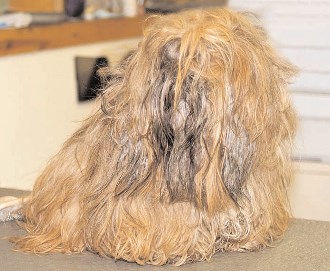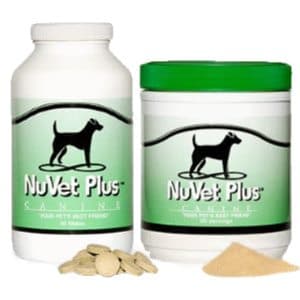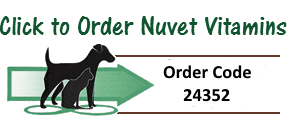Brushing a Shih Tzu Coat: Tricks of the Trade
by Janice Jones |Last updated 04-19-2023
Brushing a Shih Tzu Coat is not difficult as long as it is done frequently so mats cannot set in. The adult Shih Tzu is a double-coated breed, meaning that they have a dense outer or guard coat and a softer inner coat.
Puppies are born with a single outer coat and do not grow their inner coat until they are about 8 or 9 months old although some puppies get their second coat much sooner. Brushing a puppy is relatively easy, as their hair does not mat nearly as much as a full-grown Shih Tzu dog. Since puppies can be squirmy, its best to teach a puppy how to enjoy a brushing while they are still young and have only one coat of hair.
Often the best time to groom your pet is in the evening while you’re watching television. You can train your pup to sit quietly on your lap and enjoy your company and the pampering he will receive. Most Shih Tzu dogs learn to love being groomed, but it takes time for puppies to get to this point.
 Yes, this is really a Shih Tzu that needs brushing. This is my beloved late Mr. Kool Beans Praise Yahweh. He was father to my current stud, Toby Tao. We miss you Beanie -- You made many Beannie Babies.
Yes, this is really a Shih Tzu that needs brushing. This is my beloved late Mr. Kool Beans Praise Yahweh. He was father to my current stud, Toby Tao. We miss you Beanie -- You made many Beannie Babies.Brushing a Shih Tzu: Frequency
Ideally brushing a Shih Tzu coat should be done on a daily basis, but a once over every other day is fine too. If you only have time to brush on a weekly basis, it is important to keep the coat short and spend extra time assuring that the entire coat is thoroughly de-matted.
Brushing a Shih Tzu: Train for Grooming
You will ultimately want to train your dog to sit, stand, or lay down on a hard surface such as a grooming table or kitchen counter. It is easier in the long run to groom a dog this way rather than hoping they will behave on your lap.
When you think about it, sitting or standing on a grooming table can be a scary proposition to a small dog. The table is at the correct height for you, but it must seem like a mountaintop to a small dog. Start by taking every opportunity to pick up your dog and sit them on the grooming table or surface you plan to use. Pet them gently, rub your fingers through their hair; touch their paws, tail, ears, and muzzle.
Tell your puppy to “sit” or give the “down” command, which is the word you will use to teach him to lie down. Praise them if they respond and give a small treat. Do this several times a day, gradually working up to introducing a brush. The first few brushing sessions should be brief, positive, and enjoyable. At this stage, do not worry if you are not getting down to all layers of hair.
Tools of the Trade
Having the right type of brushes will make your job so much easier. If you are just getting started, I would recommend that you purchase a good quality pin brush and a slicker brush for finishing.
After a thorough brushing, you will also want to go over the coat with a comb. My advice is to purchase the best brushes and combs that you can afford because the higher quality tools are going to last much longer and in the end, you will save money. (I learned this the hard way).
The teeth on cheap metal combs will break off. Pins fall out of cheap pin brushes or bend making it difficult to get to the roots of the hair. Slicker brushes also wear out so pick something that will last. I have made a few recommendations below, but you may also want or need more information.
Read more about Shih Tzu Brushes
Here are two brushes that I love to use on my own dogs. Both are by Chris Christensen and they will last you a very long time. I've had mine for over a year and with 15 dogs being brushed regularly, that is a very good record! Both are available through Amazon Prime.
My Favorite Pin Brush
My Favorite Slicker Brush
HINT: OK, so I'm sure this problem only happens to me: My dogs love to eat the handles of the wooden brushes. Does Yours?
Naturally I try to keep the brushes out of reach of my dogs, but sometimes they get them despite my best efforts. Products such as bitter apple sprayed about every 2 to 3 weeks. Keeps them from nibbling on the handles even if they get to them.
Procedure for Bushing a Shih Tzu
Never Brush A Dry Coat:
Always mist with a conditioning spray before brushing.
We like to use a pin brush and work on one small section at a time. A slicker brushes is another option and will help smooth the hair after all tangles have been removed.
Prior to brushing, you should lightly mist the hair with a detangling product.
I have two favorites, Top Performance GloCoat, a reasonably priced product that last a long time. If you want to help out this site you can click the picture to the left and buy directly from Amazon.
I also love Just Divine, by Chris Christensen. We receive a tiny commission that helps support this site.
Another choice is to put about a teaspoon full of conditioner in a clean, empty spray bottle and fill the bottle up with water.
Shake the bottle until all of the conditioner has been mixed. This keeps the hair from breaking and aids in removing any small knots. You should not brush or comb a dry coat.
Begin at the dog’s foot, and brush this area first in both directions. This technique, called line brushing, requires you to part the hair in a line and brush one small section at a time. Be sure to start at the skin and work outward.
To part the hair that you want to brush, you can either use the end of a steel comb, a rat-tail comb, a knitting needle, or your fingernail. For coats that are not too thick, just lift a section of hair with your non dominant hand and begin brushing below the hair you are holding.
Be sure to work from the area closest to the
skin outward. Brush straight out several
times until the brush goes freely through the hair.
If you only brush the surface of the coat, you will only reach the outer or guard coat and will not be able to get to the inner coat. Most knots or mats form in the inner coat, so you will not be able to remove any knots that might be there.
If there are mats that you cannot remove by brushing a Shih Tzu have no fear. You can remove them with a steel comb or de-matting comb after you finish combing. If you do come to a knot, do not pull or tug at it. This will hurt the pup and make him fearful of the grooming process, something that you do not want to happen.
Brushing a Shih Tzu Tip
A good rule of thumb to remember is to brush one section at a time and no more than 10 brush strokes before moving onto another section.
Brushing should continue all over the dog’s body, legs, tail, and head. The time this takes depends on the length of the dog’s coat. The process of grooming is considerably less if you keep your Shih Tzu in a short puppy or kennel cut.
Some areas tend to mat worse than others do, especially under the arms in the soft sensitive chest area and on the neck behind and under the dog’s ear.
Use special precautions here as it is easy to hurt the dog with too rigorous of brushing.
Use extreme caution around the face, especially the eyes. Until you train your dog to stay while brushing, it is best to use a small comb around the eye and muzzle area rather than a brush.
Combing
Part of brushing a Shih Tzu involves a good once over with a comb. After you have brushed all areas of the dog, go back over the dog with a steel comb. A plastic human comb is not advisable because it just pulls at the hair.
Ideally, find a steel comb that has two separate sections, one with teeth spaced closely together, and the other where the teeth are spread farther apart. Some small knots or tangles may come out with the comb. Recall where you found any large knots as detangling the coat is the next step.
If your puppy or adult dog does not let you brush or comb his beard and mustache, consider using an old toothbrush. Most dogs will tolerate a small toothbrush and you can remove debris with it. Some dogs even begin to enjoy the brushing sensation around their face and will allow you to graduate to real combs and grooming brushes.
A trick to removing hardened debris from around the eyes is to use a flea comb, if you don't have a face comb. To remove this debris, start with a warm cotton ball moistened with water.
Dab and wipe outwards to remove any you can. Then, go over the area with a comb. Most will come out with a metal comb but if not, try a flea comb. Start at the inner corner of the eye and comb outward, clean off the flea comb and then repeat until the face is clean.
Why the Concern over Mats when Brushing a Shih Tzu?
Brushing a Shih Tzu: Tools for Removing Mats
- Your Fingers
- End of a Steel Comb
- Brush
- De-tangle comb
- Scissors (Last resort)
- Clippers (Very Last Resort)
Mats tend to creep up on us when we forget or don’t have time to comb or brush. They also happen when the entire thickness of the coat is not being brushed. Remember, it is easy to go over the top coat with a brush and make the dog look good without touching the soft inner coat where tangles begin.
Tangles can pull the hair causing discomfort on the dog. When they get too big, air cannot circulate and the skin becomes inflamed. Infection can occur in badly matted coats. Mats not only detract from the appearance of the dog’s coat, but they can also be painful to the dog.
If a dog is scratching and there is no other sign of skin irritation, it is likely that a mat is pulling on the dog’s skin. Removing large mats is also painful to the dog, so the best solution is to brush daily.
The moral of the story is tangles can be a grooming problem, but they can also lead to health problems for the dog.
Brushing a Shih Tzu: Removing Mats
Remove a mat with your fingers
There are several ways to remove mats. The best way to remove very loose, small mats is with your fingers. Locate the mat and gently pull it apart until it is loose enough to comb through the hair. You may be able to pull some of these knots out entirely with your fingertips. Remember, you must be gentle with this process.
Use the End of a Steel Comb
If the knot is tighter, you may try the end
of your steel comb. Using the edge of
the comb, gently pick at the knot, slowly dislodging parts of the knot. When it is loose enough, turn the comb around
and comb through the hair.
De-Tangling Combs
Tighter knots often require de-tangling combs or scissors.
A de-tangling comb looks like a regular comb with a sharp
edge at the base for cutting through the knot.
It is easy to begin yanking on the hair with these detangling
instruments, so go slow and gentle.

Last Resorts: Scissors or Clippers
If all else fails, you can use a pair of grooming scissors to remove the knot. There is a trick to this, so do not just find the knot and cut it out as this will leave a section of the coat bare. In addition, the chances of cutting the dog are great.
To use scissors, first locate the knot and hold it between two fingers. With your scissors in your other hand, locate the base of the knot, nearest to the skin with the tip of your scissors.
Cut through the knot from the skin towards the ends of the hair. Never point scissors or cut towards the dog’s skin, as you are likely to cut the skin.
Make several small cuts if the knot is large and then use your comb to work out the knot. If the dog’s hair is badly matter, it may be preferably to shave him down with a clipper.
If the dog has so many mats, you are faced with getting him clipped professionally or doing it yourself. If you choose to clip the dog yourself, you will need a clipper and a 5 or 7 blade. The 7 blade will go through most mats but will cut the hair short. A number 5 blade will leave a little more hair on your dog
This set got good reviews on Amazon and has most of what you need to be a great home groomer.
It comes with straight shears, curved and thinning shears. Use the straight scissors to remove a mat.

This is the clipper I use and find it to be perfect for a home setting, yet versatile enough to do a great job.
It comes with a number 10 blade, but you may want to purchase a couple more blades if you are serious about clipping your own Shih Tzu

Once all the knots are out and your Shih Tzu is looking good, you can use the end of your rat-tail comb, the end of your steel comb or a knitting needle to make a part from the dog’s neck to its tail. Add quick sprits of cologne and your dog will look wonderful.
About Janice
Janice is the voice behind Miracle Shih Tzu. Having lived with dogs and cats most of her life, she served as a veterinary technician for ten years in Maryland and twelve years as a Shih Tzu dog breeder in Ohio.
Her education includes undergraduate degrees in Psychology with a minor in biology, Early Childhood Education, and Nursing, and a master's in Mental Health Counseling.
She is a lifelong learner, a dog lover, and passionate about the welfare of animals. Her favorite breed for over 50 years has been the Shih Tzu.
When not writing, reading, or researching dog-related topics, she likes to spend time with her eight Shih Tzu dogs, her husband, and her family, as well as knitting and crocheting. She is also the voice behind Small Dog Place and smart knit crocheting.










